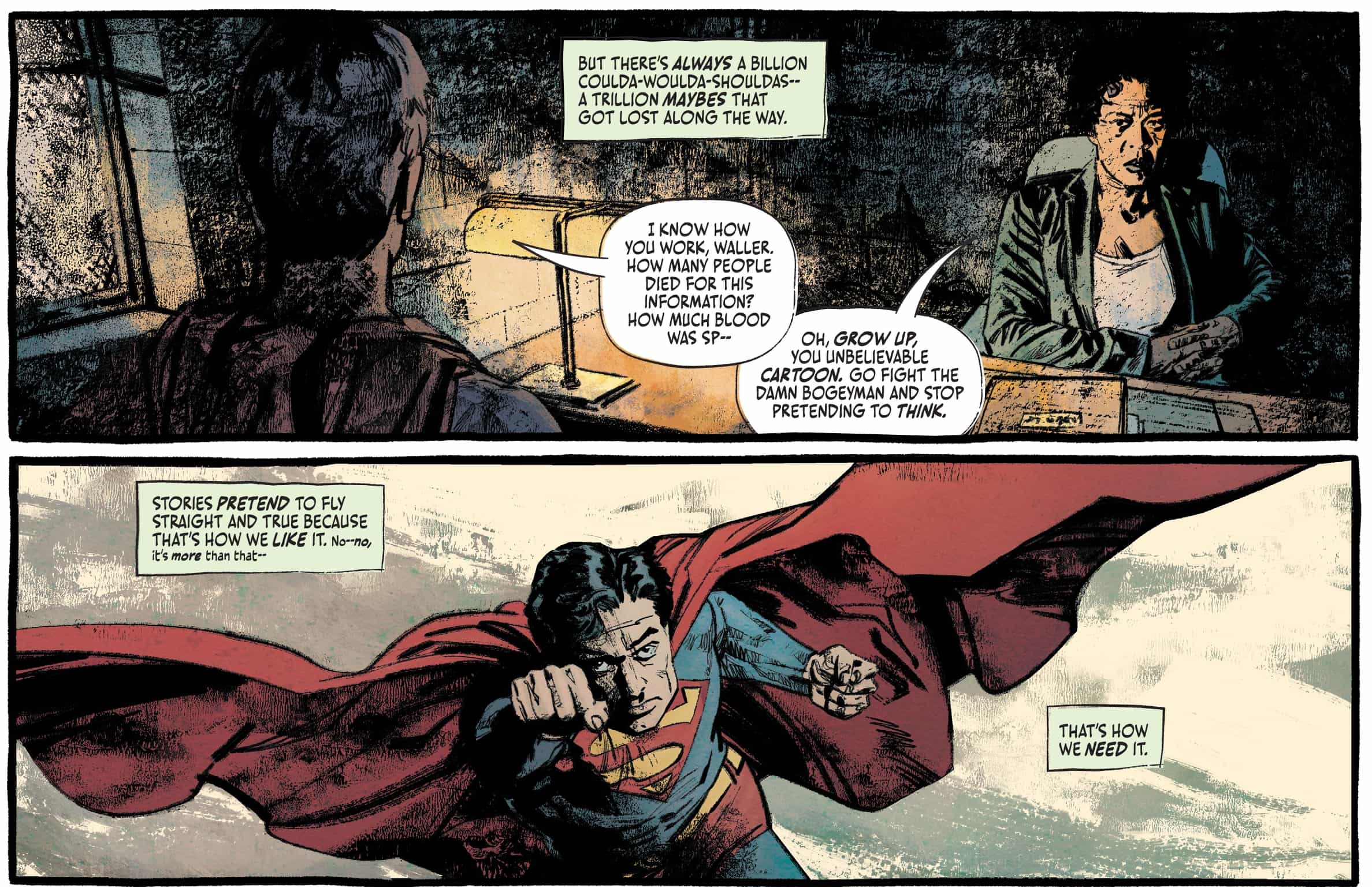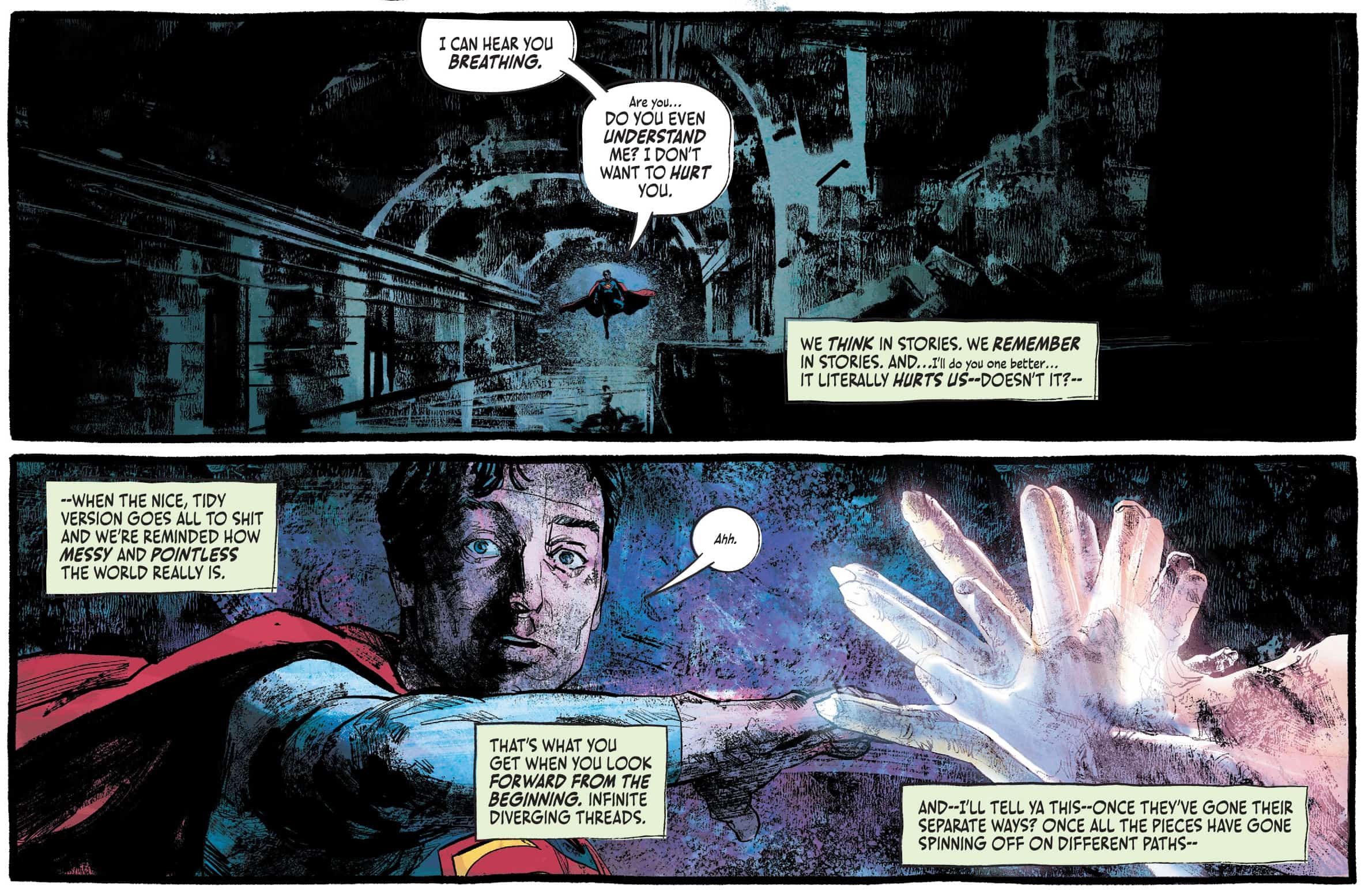Suicide Squad Blaze #2

Recap
The Suicide Squad: Blaze team only has three months to live, but after absorbing the powers of one of their teammates, that time is even shorter. Can the team stop the Creature stalking the skies or will they tear each other apart before the monster does it for them?
Review
Si Spurrier is really good at writing horror.

While Suicide Squad: Blaze retains most of the trope and characterizations that make Suicide Squad stories fun and enjoyable, Spurrier has managed to infuse this particular story with a great sense of looming danger as the world finds itself less and less able to figure out how to deal with the super powered serial killer stalking its skies. The threat is treated as a wild animal, hunting, killing gruesomely and then scurrying back into its hole when it’s tired or full – Spurrier makes sure that readers are aware that it’s a creature of pure instinct and power and posits it as the complete opposite of what Amanda Waller is able to counter. Always the forward thinker, Waller makes plans and one after another, they all fail because the creature is unpredictable and stronger than her Blaze-powered team of misfits.
One of the best things about this book are its characters. While Harley Quinn, Captain Boomerang, King Shark and Peacemaker act as the recognizable names of the team, the core Squad consists of a few characters that have managed to very compelling, like Lucille who shook a baby to death and seeks her own demise as part of the Squad and gains some sort of ghost-like shifting power; Tanya who just loves the rush and excitement that life and bring; and finally Michael van Zandt whose power is invisible arms. He has no real personality trait except for a codependent personality disorder which makes him latch on to Tanya, providing a great character flaw. They work together to bring a sense of levity to the abject terror that they’re in.
Aaron Campbell’s art alongside Jordie Bellaire’s colors are truly what make this book as horrific as it is.

Campbell has this uncanny ability to draw scenes with a sense of realism and within a panel have them with this scratchy, painterly style to them, depicting violence and chaos almost imperceptible to the eyes. When Superman finds and confronts the beast, he is attacked by a trippy haze of multiple hands disappearing into each other, one, two or more heads and even more mouths than should be possible. He makes use of blurs to convey the frantic terror of the scene and Superman fighting back – bodies weave in and out of each other before an entire CHUNK of Superman’s brain is ripped from his head. It’s one of the most horrifying and amazing openings to a comic that I have ever seen.
Even better is that this scene is juxtaposed against panels of a more calm act of “love-making” between Tanya and van Zandt which ends after van Zandt can’t seem to replicate him burning through her arm to give her more feeling. The entire book is filled with moments like this. Fights, complete with masses of body parts and heavy lighting effects from all of the various energy blasts filling the screen and then moments of respite in which we get to explore characters. Aaron Campbell is very good at drawing faces, whether they be angry, terrified or shark-frenzied. It’s one of the things that makes these characters relatable. And one of the best cases of his art, that mixes elements of both, is when van Zandt is trapped under some of the rubble and come face-to-face with the creature and we get a reveal of who or what it is. Its face and eyes show nothing but madness and it’s one of those kinds of images that seems innocuous but will stick with you long after reading.

Of course, none of this works as well as it does without an amazing colorist like Jordie Bellaire to give it life. Bellaire’s colors pop off the page with every single scene. When van Zandt and Tanya make love, they’re shrouded in a haze that emanates a neon-ish toxic green, the same color as their relationship. When Superman is attacked, the creature is painted with hues of purple and red. This acts as something of a bastardization of Superman’s own colors and reflects the violence that the Creature represents against Superman’s own heroism and hope. Scenes during the night take on the color of a dim blue and help to set the tone of eeriness and horror before coming alight with flashes of light greens and hot yellows, displaying the use of powers and how their hosts burn out after using them far too much.
Some of Bellaire’s best colors come in towards the end of the book when the Squad and the Creature face off in a volcanic environment during the night and the scene is lit by the burning hot oranges of the lava surrounding them. It serves as an excellent backdrop that gives the scene an intensity after other events in the book leave the situation looking less than ideal. Bellaire’s colors evoke every emotion under the sun throughout this book and it’s sort of unfortunate that in some parts of it, the colors can be a bit too bright – this combined with Campbell’s art in some panels makes things look a little bit too chaotic and hard to follow with very little grasp of what one is looking at, but it overall is still fantastic.
Final Thoughts
Suicide Squad: Blaze is amazingly dark fun. Si Spurrier, Aaron Campbell and Jordie Bellaire have found a way to turn one note characters into fun additions to a world and have created one of the more terrifyingly animalistic villains we’ve seen in a long time. This, quite possibly, might be one of the best Suicide Squad books I have ever read especially because of the amazing art and great storytelling.
Suicide Squad Blaze #2: Monstrous Parallels
- Writing - 8.5/108.5/10
- Storyline - 8/108/10
- Art - 9/109/10
- Color - 9.5/109.5/10
- Cover Art - 8/108/10





